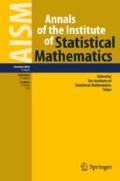Abstract
In this paper, we first describe the generalized notion of Cramer–Rao lower bound obtained by Naudts (J Inequal Pure Appl Math 5(4), Article 102, 2004) using two families of probability density functions: the original model and an escort model. We reinterpret the results in Naudts (2004) from a statistical point of view and obtain some interesting examples in which this bound is attained. Further, we obtain information inequalities which generalize the classical Bhattacharyya bounds in both regular and non-regular cases.
Similar content being viewed by others
References
Amari, S. (1985). Differential-geometrical methods in statistics, Lecture notes in statistics, Vol. 28. New York: Springer.
Amari, S., Ohara, A., Matsuzoe, H. (2012). Geometry of deformed exponential families: Invariant, dually flat and conformal geometries. Physica A: Statistical Mechanics and Its Applications, 391, 4308–4319.
Chapman, D. G., Robbins, H. (1951). Minimum variance estimation without regularity assumptions. Annals of Mathematical Statistics, 22(4), 581–586.
Cramer, H. (1946). A contribution to the theory of statistical estimation. Scandinavian Actuarial Journal, 1, 85–94.
Fraser, D. A. S., Guttman, I. (1952). Bhattacharyya bounds without regularity assumptions. Annals of Mathematical Statistics, 23(4), 629–632.
Hammersley, J. M. (1950). On estimating restricted parameters. Journal of the Royal Statistical Society Series B, 12(2), 192–240.
Harsha, K. V., Subrahamanian Moosath, K. S. (2015). Dually flat geometries of the deformed exponential family. Physica A: Statistical Mechanics and its Applications, 433, 136–147.
Khatri, C. G. (1980). Unified treatment of Cramér–Rao bound for the nonregular density functions. Journal of Statistical Planning and Inference, 4, 75–79.
Koike, K. (2002). On the inequality of Kshirsagar. Communications in Statistics: Theory and Methods, 31, 1617–1627.
Kshirsagar, A. M. (2000). An extension of the Chapman–Robbins inequality. Journal of the Indian Statistical Association, 38, 355–362.
Lehmann, E. L., Casella, G. (1998). Theory of point estimation, 2nd ed. New York: Springer.
Matsuzoe, H., Henmi, M. (2013). Hessian structures on deformed exponential families. In F. Nielsen, F. Barbaresco (Eds.), Geometric science of information, Lecture notes in computer science, Vol. 8085, pp. 275–282. Berlin: Springer.
Naudts, J. (2004). Estimators, escort probabilities, and \(\phi \)-exponential families in statistical physics. Journal of Inequalities in Pure and Applied Mathematics, 5(4), Article 102.
Qin, M., Nayak, T. K. (2008). Kshirsagar-type lower bounds for mean squared error of prediction. Communications in Statistics: Theory and Methods, 37, 861–872.
Rao, C. R. (1945). Information and the accuracy attainable in the estimation of statistical parameters. Bulletin of the Calcutta Mathematical Society, 37, 81–89.
Vincze, I. (1979). On the Cramer–Frechet–Rao inequality in the non-regular case. In Contributions to statistics, The Jaroslav Hajek Memorial Volume, pp. 253–262. Prague: Academia.
Acknowledgements
The first author is supported by the Postdoctoral Fellowship from Indian Institute of Technology Bombay, Mumbai, India.
Author information
Authors and Affiliations
Corresponding author
Additional information
Publisher's Note
Springer Nature remains neutral with regard to jurisdictional claims in published maps and institutional affiliations.
Appendix
Appendix
Lemma 1
Let X be a random variable with pdf
Consider a pdf
Then the family \(\{ g_{\theta } \mid \theta >0\}\) satisfies Assumptions (18) and (19).
Proof
Since \(\mathrm {supp}(g_{\theta }) = \mathrm {supp}(f_{\theta })\), \( P_{g_{\theta }} \) is absolutely continuous with respect to \( P_{f_{\theta }} \) for all \(\theta \in \varTheta \). Hence, \(\{ g_{\theta } \mid \theta >0\}\) satisfies Assumption (18).
To show \(\mathcal {U}_{f} \subseteq \mathcal {U}_{g}\), let \(U(X) \in \mathcal {U}_{f}\). Then we have for all \(\theta \in \varTheta \),
By differentiating (107) both sides with respect to \(\theta \), we get
Now from Eqs. (107) and (108), it follows that
Hence, \(\{ g_{\theta } \mid \theta >0\}\) satisfies Assumption (19). \(\square \)
About this article
Cite this article
Harsha, K.V., Subramanyam, A. Some information inequalities for statistical inference. Ann Inst Stat Math 72, 1237–1256 (2020). https://doi.org/10.1007/s10463-019-00725-3
Received:
Revised:
Published:
Issue Date:
DOI: https://doi.org/10.1007/s10463-019-00725-3




